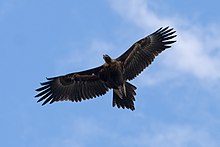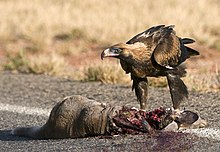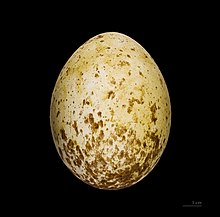Wedge-tailed eagle
| Wedge-tailed eagle | ||||||||||
|---|---|---|---|---|---|---|---|---|---|---|

Wedge-tailed eagle ( Aquila audax ) |
||||||||||
| Systematics | ||||||||||
|
||||||||||
| Scientific name | ||||||||||
| Aquila audax | ||||||||||
| ( Latham , 1802) |
The wedge-tailed eagle ( Aquila audax ) is a bird of prey art from the family of Accipitridae (Accipitridae). This very large, somewhat lanky looking eagle inhabits a very broad spectrum of habitats in almost all of Australia including Tasmania and in the extreme south of New Guinea . Wedge-tailed eagles feed primarily on medium-sized mammals , reptiles and birds are less common . Especially outside the breeding season and generally for young birds, carrion also plays an important role as food. The worldwide population is considered to be increasing and is not endangered.
description
Wedge-tailed eagles are very large, somewhat lanky-looking and very dark representatives of the genus Aquila with long, relatively slender wings, a very long, wedge-shaped tail, relatively small head, large and powerful beak and fluffy leg plumage. They are among the largest representatives of the subfamily Aquilinae . The body length is 85 to 106 cm and the wingspan is 1.82 to 2.32 m; the species is about the same size as the golden eagle . The gender dimorphism is relatively small in terms of size, but very pronounced in terms of weight. Males weigh 2.03 to 4.00 kg and have a wing length of 553 to 667 mm, females reach a weight of 3.05 to 5.30 kg and a wing length of 600 to 703 mm. As with all representatives of the Aquila genus , the tips of the hand wings are heavily fingered and the legs are feathered up to the toes.
Overall, adult birds are almost solid black. The back of the head and neck are dotted with dark brownish red lines on a black background. The large upper wing coverts have a light gray-brown border and therefore form an irregular light band on the upper wing. The under tail coverts are clearly light brown to reddish brown in contrast to the otherwise black trunk. The bases of the flight feathers are grayish, distal the flight feathers as well as the control feathers are black.

The iris is light brown, the wax skin and the toes are creamy white. The beak is whitish gray at the base and blackish towards the tip.
The juvenile plumage differs significantly from that of the adult birds. The head and chest are very intense, light reddish brown dashed on a dark brown background. The neck and upper back are light reddish brown. The large, middle and partly also the small upper wing coverts are also light reddish brown, the wing band created here is significantly wider than in adult birds. The rest of the trunk, the small upper wing-coverts and the legs are dark brown with light reddish-brown feather edges. The control feathers, the arm wings as well as the inner hand wings are banded dark gray on a gray background, the outer hand wings are black with a gray base, as in adult birds. The iris is darker brown than in adults, the beak, wax skin and toes are more yellow. The young birds are colored after 7–8 years.
Vocalizations
Wedge-tailed eagles are mostly mute outside of the breeding season. The calls, which are noticeably quiet and not very penetrating for a bird of this size, can only be heard at the nest and during courtship flights. The most common call is a thin, high-pitched whistle followed by a sloping "siii-tjuu". In addition, the eagles utter various other and sometimes lined up, whistling, howling and yapping calls.
distribution and habitat
The species populates almost all of Australia including Tasmania and the extreme south of New Guinea . The size of the total distribution area is about 7.68 million km². The animals occur from sea level up to 2000 m altitude.
Wedge-tailed eagles inhabit landscapes of almost every type, from mountain forests to open woodland and savannah to treeless plains. Only deserts , areas used intensively for agriculture and the vicinity of larger cities are avoided .
Systematics
Two subspecies are recognized:
- Aquila audax audax ( Latham , 1802) - Largest part of the range.
- Aquila a. fleayi Condon and Amadon , 1954 - Tasmania. The nuchal lines are more whitish reddish brown.
After a molecular genetic investigation of the mitochondrial DNA and the DNA of the cell nucleus, the closest relative of the wedge-tailed eagle is the Moluccan eagle ( A. gurneyi ), which is also spatially adjacent , both species together represent the sister taxon of the coffee eagle ( A. verreauxii ).
Way of hunting and food


Wedge-tailed eagles feed primarily on ground-dwelling, medium-sized mammals ; reptiles such as monitor lizards and bearded dragons as well as birds are less common .
Wherever the wild rabbits naturalized in Australia are common, these are almost always the main diet today; young kangaroos , Australian nosebags , naturalized rabbits , domestic cats, young dogs, foxes and goat and sheep lambs are still eaten. It is controversial whether the latter are only weakened or healthy as prey for the wedge-tailed eagle. Especially outside the breeding season and generally for young birds, carrion also plays an important role as food.
Most of the prey is hunted on the ground from a low-level search flight, less often from the hide. Occasionally these eagles also pull cusus and other mammals from tree hollows, fetch young birds from nests or prey from other predators. Wedge-tailed eagles usually hunt individually or in pairs, in one case the cooperative hunt of 15 individuals on a red giant kangaroo ( Macropus rufus ) was observed. 5–12, up to a maximum of 40, mainly juvenile and immature wedge-tailed eagles can be found on large carrion .
Reproduction
The courtship consists mostly of the high circles of one or both couple partners over the breeding place, it is also called. Occasionally the eagles throw themselves on their backs in flight or show wave-like flights, with diving flights alternating with gliding up again.
The nests are mainly erected on single or dense trees, mostly on a side branch at a height of 12–30 m, and a maximum of 73 m. Where trees are rare, however, the trees used to create nests are much smaller or the nest is built on rocks or even on the ground. The nests are usually large and often huge structures made of branches, the nest hollow is laid out with thinner and green branches. New nests are sometimes only 1.0 m in diameter and 0.75 m in height; however, old nests that are used several times can reach a diameter of 2.5 m and heights of up to 4.0 m.
The breeding season falls in most of the range between July and December. In the far north of Australia clutches were found in January and February, in Tasmania in September. In the west of Australia, the amount of food available is heavily dependent on precipitation; in periods of drought, wedge-tailed eagles brood there for up to 4 years. The clutches usually consist of one to two, a maximum of four eggs. The incubation period is 42–48 days, the nestling period 70–95 days. The young birds remain dependent on their parents for up to six months after they have fled.
Existence and endangerment
There is no reliable information about the size of the world population, Ferguson-Lees and Christie estimated it at several 100,000 birds in 2001, BirdLife International only gives 100,000 birds for 2010. In Australia, most of the breeding records come from around the eastern third, but the species is apparently most common in the arid areas in the west, middle and south of the continent.
The clearing of the forests of Australia and, above all, the naturalization of the wild rabbit were certainly beneficial for the wedge-tailed eagle and it is probably more common today than before the colonization of Australia by Europeans. The world population is considered to be increasing and according to IUCN ![]() (= least concern - not endangered). The population of the Tasmanian subspecies A. a. However, fleayi has decreased from 140 pairs in the 1980s to only 60–80 pairs in the 1990s, which is why it is now considered to be endangered.
(= least concern - not endangered). The population of the Tasmanian subspecies A. a. However, fleayi has decreased from 140 pairs in the 1980s to only 60–80 pairs in the 1990s, which is why it is now considered to be endangered.
swell
Individual evidence
- ↑ a b c d J. Ferguson-Lees, DA Christie: Raptors of the World. Christopher Helm, London, 2001. ISBN 0-7136-8026-1 : p. 748
- ↑ a b BirdLife International (2010) Species factsheet: Aquila audax. Online , accessed August 15, 2010
- ↑ HRL Lerner and DP Mindell: Phylogeny of eagles, Old World vultures and other Accipitridae based on nuclear and mitochondrial DNA . Molecular Phylogenetics and Evolution 37; 2005: pp. 327-346
literature
- James Ferguson-Lees , David A. Christie : Raptors of the World. Christopher Helm, London, 2001: pp. 234-235 and 746-748. ISBN 0-7136-8026-1
- Penny Olsen , Humphrey Price-Jones (Illustrator): Wedge-tailed Eagle CSIRO Publishing, 2005, ISBN 0-643-09165-3 .
Web links
- Aquila audax in the Red List of Threatened Species of the IUCN 2010. Posted by: BirdLife International, 2009. Accessed August 13 of 2010.
Other web links
- Videos, photos and sound recordings for Aquila audax in the Internet Bird Collection

